ESP PORSCHE CAYNNE 2010 1.G Information Manual
[x] Cancel search | Manufacturer: PORSCHE, Model Year: 2010, Model line: CAYENNE, Model: PORSCHE CAYENNE 2010 1.GPages: 68, PDF Size: 4.52 MB
Page 16 of 68
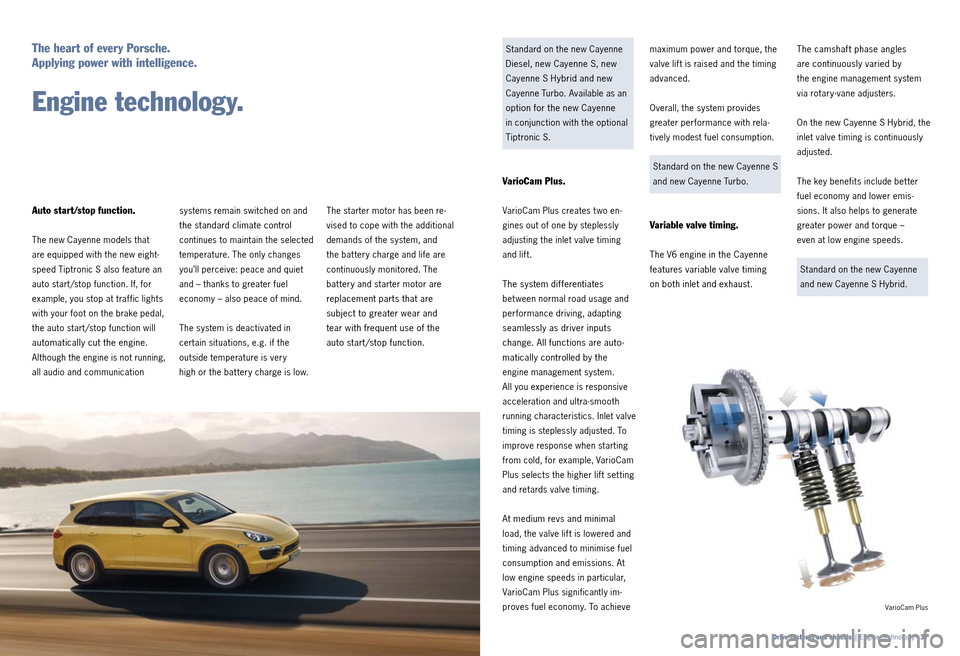
Standard on the new Cayenne
Diesel, new Cayenne S, new
Cayenne S Hybrid and new
Cayenne Turbo. Available as an
option for the new Cayenne
in conjunction with the optional
Tiptronic S.
VarioCam Plus.
VarioCam Plus creates t wo en
gines out of one by steplessly
adjusting the inlet valve timing
and lift.
The system dif ferentiates
bet ween normal road usage and
performance driving, adapting
seamlessly as driver inputs
change. All functions are auto
matically controlled by the
engine management system.
All you experience is responsive
acceleration and ultra smooth
running characteristics. Inlet valve
timing is steplessly adjusted. To
improve response when starting
from cold, for example, VarioCam
Plus selects the higher lif t set ting
and retards valve timing.
At medium revs and minimal
load, the valve lif t is lowered and
timing advanced to minimise fuel
consumption and emissions. At
low engine speeds in particular,
VarioCam Plus significantly im
proves fuel economy. To achieve maximum power and torque, the
valve lif t is raised and the timing
advanced.
Overall, the system provides
greater performance with rela
tively modest fuel consumption.
Standard on the new Cayenne S
and new Cayenne Turbo.
Variable valve timing.
The V6 engine in the Cayenne
features variable valve timing
on both inlet and exhaust. The camshaft phase angles
are continuously varied by
the engine management system
via rotary vane adjusters.
On the new Cayenne S Hybrid, the
inlet valve timing is continuously
adjusted.
The key benefits include bet ter
fuel economy and lower emis
sions. It also helps to generate
greater power and torque –
even at low engine speeds.
Standard on the new Cayenne
and new Cayenne S Hybrid.
The starter motor has been re
vised to cope with the additional
demands of the system, and
the bat tery charge and life are
continuously monitored. The
bat tery and starter motor are
replacement parts that are
subject to greater wear and
tear with frequent use of the
auto start /stop function.
systems remain switched on and
the standard climate control
continues to maintain the selected
temperature. The only changes
you’ll perceive: peace and quiet
and – thanks to greater fuel
economy – also peace of mind.
The system is deactivated in
certain situations, e.g. if the
outside temperature is very
high or the bat tery charge is low.
Auto start/stop function.
The new Cayenne models that
are equipped with the new eight
speed Tiptronic S also feature an
auto start /stop function. If, for
example, you stop at traf fic lights
with your foot on the brake pedal,
the auto start /stop function will
automatically cut the engine.
Although the engine is not running,
all audio and communication
The heart of every Porsche.
Applying power with intelligence.
Engine technology.
VarioCam Plus
Drive systems and chassis | Engine technology · 37
Page 17 of 68
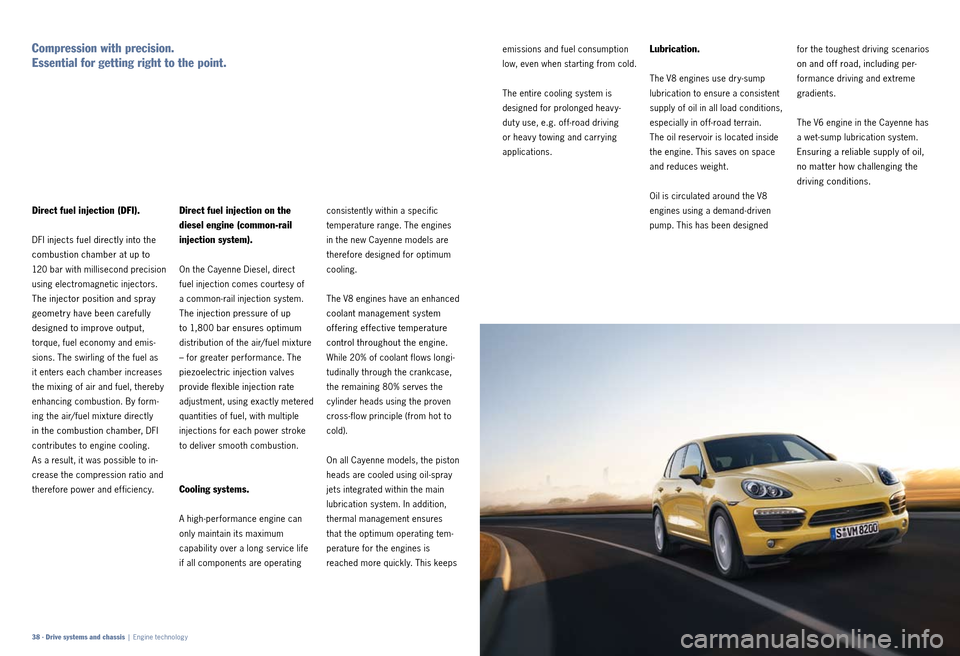
consistently within a specific
temperature range. The engines
in the new Cayenne models are
therefore designed for optimum
cooling.
The V8 engines have an enhanced
coolant management system
offering effective temperature
control throughout the engine.
While 20% of coolant flows longi
tudinally through the crankcase,
the remaining 80% serves the
cylinder heads using the proven
cross flow principle (from hot to
cold).
On all Cayenne models, the piston
heads are cooled using oil spray
jets integrated within the main
lubrication system. In addition,
thermal management ensures
that the optimum operating tem
perature for the engines is
reached more quickly. This keeps emissions and fuel consumption
low, even when starting from cold.
The entire cooling system is
designed for prolonged heav y
dut y use, e.g. of f road driving
or heav y towing and carrying
applications.
Lubrication.
The V8 engines use dry sump
lubrication to ensure a consistent
supply of oil in all load conditions,
especially in of f road terrain.
The oil reservoir is located inside
the engine. This saves on space
and reduces weight.
Oil is circulated around the V8
engines using a demand driven
pump. This has been designed for the toughest driving scenarios
on and off road, including per
formance driving and extreme
gradients.
The V6 engine in the Cayenne has
a wet sump lubrication system.
Ensuring a reliable supply of oil,
no mat ter how challenging the
driving conditions.
Direct fuel injection on the
diesel engine (common-rail
injection system).
On the Cayenne Diesel, direct
fuel injection comes courtesy of
a common rail injection system.
The injection pressure of up
to 1,800 bar ensures optimum
distribution of the air/fuel mixture
– for greater performance. The
piezoelectric injection valves
provide flexible injection rate
adjustment, using exactly metered
quantities of fuel, with multiple
injections for each power stroke
to deliver smooth combustion.
Cooling systems.
A high performance engine can
only maintain its maximum
capabilit y over a long service life
if all components are operating
Direct fuel injection (DFI).
DFI injects fuel directly into the
combustion chamber at up to
120 bar with millisecond precision
using electromagnetic injectors.
The injector position and spray
geometry have been carefully
designed to improve output,
torque, fuel economy and emis
sions. The swirling of the fuel as
it enters each chamber increases
the mixing of air and fuel, thereby
enhancing combustion. By form
ing the air/fuel mixture directly
in the combustion chamber, DFI
contributes to engine cooling.
As a result, it was possible to in
crease the compression ratio and
therefore power and efficiency.
Compression with precision.
Essential for getting right to the point.
38 · Drive systems and chassis | Engine technology
Page 18 of 68
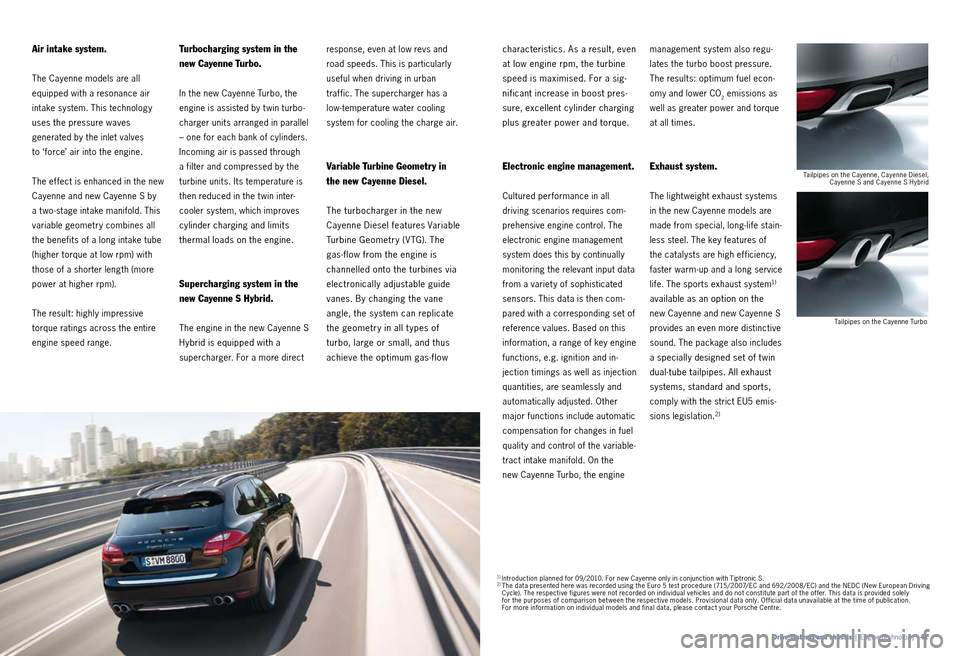
response, even at low revs and
road speeds. This is particularly
useful when driving in urban
traf fic. The supercharger has a
lowtemperature water cooling
system for cooling the charge air.
Variable Turbine Geometry in
the new Cayenne Diesel.
The turbocharger in the new
Cayenne Diesel features Variable
Turbine Geometry (V TG). The
gas flow from the engine is
channelled onto the turbines via
electronically adjustable guide
vanes. By changing the vane
angle, the system can replicate
the geometry in all t ypes of
turbo, large or small, and thus
achieve the optimum gas flow characteristics. As a result, even
at low engine rpm, the turbine
speed is maximised. For a sig
nificant increase in boost pres
sure, excellent cylinder charging
plus greater power and torque.
Electronic engine management.
Cultured performance in all
driving scenarios requires com
prehensive engine control. The
electronic engine management
system does this by continually
monitoring the relevant input data
from a variet y of sophisticated
sensors. This data is then com
pared with a corresponding set of
reference values. Based on this
information, a range of key engine
functions, e.g. ignition and in
jection timings as well as injection
quantities, are seamlessly and
automatically adjusted. Other
major functions include automatic
compensation for changes in fuel
qualit y and control of the variable
tract intake manifold. On the
new Cayenne Turbo, the engine management system also regu
lates the turbo boost pressure.
The results:
optimum fuel eco
n
omy and lower CO
2 emissions as
well as greater power and torque
at all times.
Exhaust system.
The light weight exhaust systems
in the new Cayenne models are
made from special, long life stain
less steel. The key features of
the catalysts are high ef ficiency,
faster warm up and a long service
life. The sports exhaust system
1)
available as an option on the
new Cayenne and new Cayenne S
provides an even more distinctive
sound. The package also includes
a specially designed set of t win
dual tube tailpipes. All exhaust
systems, standard and sports,
comply with the strict EU5 emis
sions legislation.
2)
Turbocharging system in the
new Cayenne Turbo.
In the new Cayenne Turbo, the
engine is assisted by t win turbo
charger units arranged in parallel
– one for each bank of cylinders.
Incoming air is passed through
a filter and compressed by the
turbine units. Its temperature is
then reduced in the t win inter
cooler system, which improves
cylinder charging and limits
thermal loads on the engine.
Supercharging system in the
new Cayenne S Hybrid.
The engine in the new Cayenne S
Hybrid is equipped with a
supercharger. For a more direct
Air intake system.
The Cayenne models are all
equipped with a resonance air
intake system. This technology
uses the pressure waves
generated by the inlet valves
to ‘force’ air into the engine.
The ef fect is enhanced in the new
Cayenne and new Cayenne S by
a t wo stage intake manifold. This
variable geometry combines all
the benefits of a long intake tube
(higher torque at low rpm) with
those of a shorter length (more
power at higher rpm).
The result: highly impressive
torque ratings across the entire
engine speed range.
1 ) Introduction planned for 09/2010. For new Cayenne only in conjunction with Tiptronic S.2) The data presented here was recorded using the Euro 5 test procedure (715/2007/ EC and 692/2008/ EC) and the NEDC (New European Driving
Cycle). The respective figures were not recorded on individual vehicles and do not constitute part of the of fer. This data is provided solely
for the purposes of comparison bet ween the respective models. Provisional data only. Of ficial data unavailable at the time of publication.
For more information on individual models and final data, please contact your Porsche Centre. Tailpipes on the Cayenne, Cayenne Diesel,
Cayenne S and Cayenne S Hybrid
Tailpipes on the Cayenne Turbo
Drive systems and chassis | Engine technology · 41
Page 20 of 68
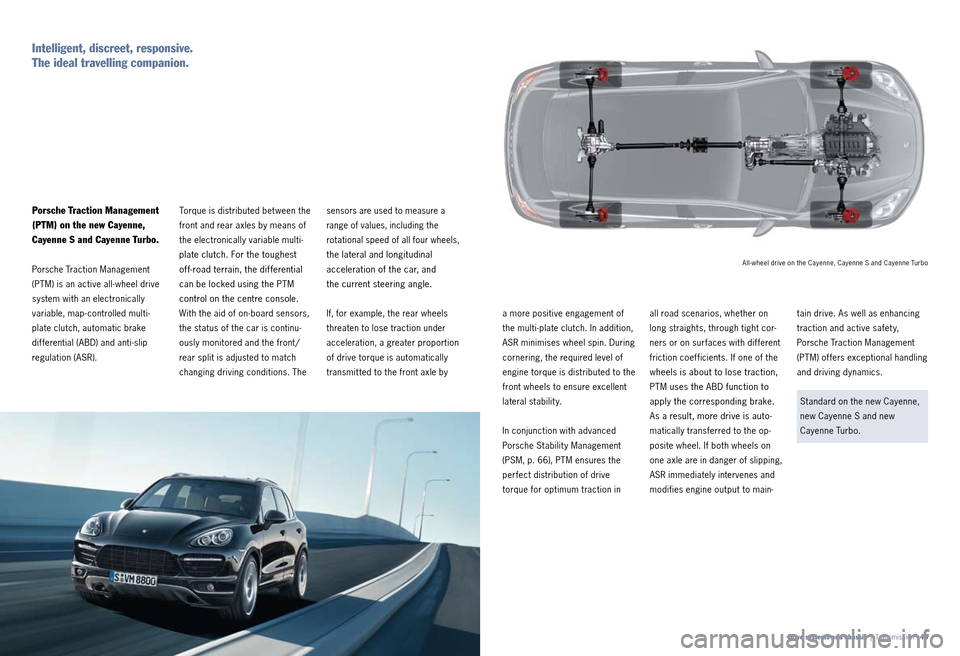
sensors are used to measure a
range of values, including the
rotational speed of all four wheels,
the lateral and longitudinal
acceleration of the car, and
the current steering angle.
If, for example, the rear wheels
threaten to lose traction under
acceleration, a greater proportion
of drive torque is automatically
transmit ted to the front axle by a more positive engagement of
the multi
plate clutch. In addition,
ASR minimises wheel spin. During
cornering, the required level of
engine torque is distributed to the
front wheels to ensure excellent
lateral stabilit y.
In conjunction with advanced
Porsche Stabilit y Management
(PSM, p. 66), PTM ensures the
perfect distribution of drive
torque for optimum traction in all road scenarios, whether on
long straights, through tight cor
ners or on surfaces with dif ferent
friction coef ficients. If one of the
wheels is about to lose traction,
PTM uses the ABD function to
apply the corresponding brake.
As a result, more drive is auto
matically transferred to the op
posite wheel. If both wheels on
one axle are in danger of slipping,
ASR immediately intervenes and
modifies engine output to main tain drive. As well as enhancing
traction and active safet y,
Porsche Traction Management
(PTM) of fers exceptional handling
and driving dynamics.
Standard on the new Cayenne,
new Cayenne S and new
Cayenne Turbo.
Torque is distributed bet ween the
front and rear axles by means of
the electronically variable multi
plate clutch. For the toughest
off road terrain, the differential
can be locked using the PTM
control on the centre console.
With the aid of on board sensors,
the status of the car is continu
ously monitored and the front /
rear split is adjusted to match
changing driving conditions. The
Porsche Traction Management
(PTM) on the new Cayenne,
Cayenne S and Cayenne Turbo.
Porsche Traction Management
(PTM) is an active all wheel drive
system with an electronically
variable, map controlled multi
plate clutch, automatic brake
dif ferential (ABD) and anti slip
regulation (ASR).
Intelligent, discreet, responsive.
The ideal travelling companion.
All wheel drive on the Cayenne, Cayenne S and Cayenne Turbo
Drive systems and chassis | Transmission · 45
Page 24 of 68
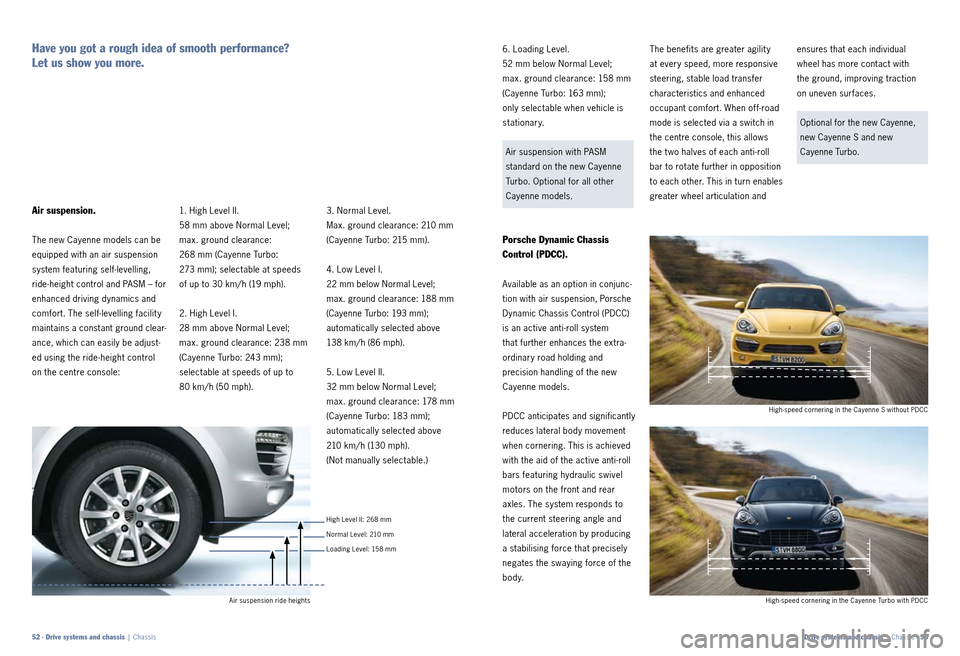
3. Normal Level.
Max. ground clearance: 210 mm
(Cayenne Turbo: 215 mm).
4. Low Level I.
22 mm below Normal Level;
max. ground clearance: 188 mm
(Cayenne Turbo: 193 mm);
automatically selected above
138 km/ h (86 mph).
5. Low Level II.
32 mm below Normal Level;
max. ground clearance: 178 mm
(Cayenne Turbo: 183 mm);
automatically selected above
210 km/ h (130 mph).
(Not manually selectable.) 6. Loading Level.
52 mm below Normal Level;
max. ground clearance: 158 mm
(Cayenne Turbo: 163 mm);
only selectable when vehicle is
stationary.
Air suspension with PASM
standard on the new Cayenne
Turbo. Optional for all other
Cayenne models.
Porsche Dynamic Chassis
Control (PDCC).
Available as an option in conjunc
tion with air suspension, Porsche
Dynamic Chassis Control (PDCC)
is an active anti roll system
that further enhances the extra
ordinary road holding and
precision handling of the new
Cayenne models.
PDCC anticipates and significantly
reduces lateral body movement
when cornering. This is achieved
with the aid of the active anti roll
bars featuring hydraulic swivel
motors on the front and rear
axles. The system responds to
the current steering angle and
lateral acceleration by producing
a stabilising force that precisely
negates the swaying force of the
body. The benefits are greater agilit y
at every speed, more responsive
steering, stable load transfer
characteristics and enhanced
occupant comfort. When off
road
mode is selected via a switch in
the centre console, this allows
the t wo halves of each anti roll
bar to rotate further in opposition
to each other. This in turn enables
greater wheel articulation and ensures that each individual
wheel has more contact with
the ground, improving traction
on uneven surfaces.
Optional for the new Cayenne,
new Cayenne S and new
Cayenne Turbo.
1. High Level II.
58 mm above Normal Level;
max. ground clearance:
268 mm (Cayenne Turbo:
273 mm); selectable at speeds
of up to 30 km/ h (19 mph).
2. High Level I.
28 mm above Normal Level;
max. ground clearance: 238 mm
(Cayenne Turbo: 243 mm);
selectable at speeds of up to
80 km/ h (50 mph). Air suspension.
The new Cayenne models can be
equipped with an air suspension
system featuring self levelling,
ride height control and PASM – for
enhanced driving dynamics and
comfort. The self levelling facilit y
maintains a constant ground clear
ance, which can easily be adjust
ed using the ride height control
on the centre console:
Have you got a rough idea of smooth performance?
Let us show you more.
High speed cornering in the Cayenne Turbo with PDCC
High
speed cornering in the Cayenne S without PDCC
52 · Drive systems and chassis | ChassisDrive systems and chassis | Chassis · 53
Air suspension ride heights Loading Level: 158 mm Normal Level: 210 mm High Level II: 268 mm
Page 25 of 68
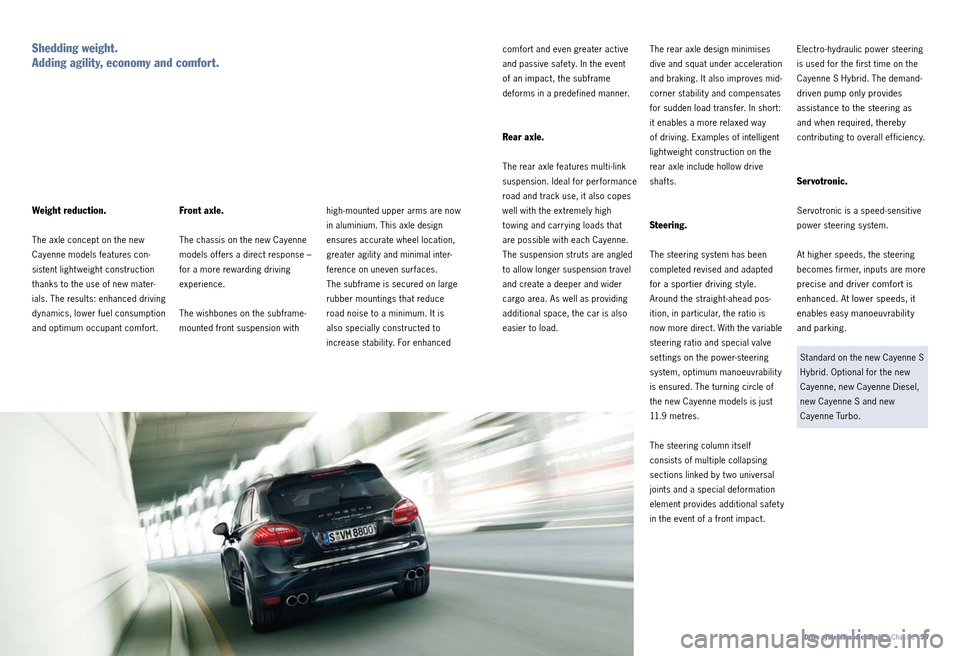
highmounted upper arms are now
in aluminium. This axle design
ensures accurate wheel location,
greater agilit y and minimal inter
ference on uneven surfaces.
The subframe is secured on large
rubber mountings that reduce
road noise to a minimum. It is
also specially constructed to
increase stabilit y. For enhanced comfort and even greater active
and passive safet y. In the event
of an impact, the subframe
deforms in a predefined manner.
Rear axle.
The rear axle features multi
link
suspension. Ideal for performance
road and track use, it also copes
well with the extremely high
towing and carrying loads that
are possible with each Cayenne.
The suspension struts are angled
to allow longer suspension travel
and create a deeper and wider
cargo area. As well as providing
additional space, the car is also
easier to load. The rear axle design minimises
dive and squat under acceleration
and braking. It also improves mid
corner stabilit y and compensates
for sudden load transfer. In short:
it enables a more relaxed way
of driving. Examples of intelligent
light weight construction on the
rear axle include hollow drive
shafts.
Steering.
The steering system has been
completed revised and adapted
for a sportier driving st yle.
Around the straight ahead pos
ition, in particular, the ratio is
now more direct. With the variable
steering ratio and special valve
set tings on the power steering
system, optimum manoeuvrabilit y
is ensured. The turning circle of
the new Cayenne models is just
11.9 metres.
The steering column itself
consists of multiple collapsing
sections linked by t wo universal
joints and a special deformation
element provides additional safet y
in the event of a front impact. Electro
hydraulic power steering
is used for the first time on the
Cayenne S Hybrid. The demand
driven pump only provides
assistance to the steering as
and when required, thereby
contributing to overall efficiency.
Servotronic.
Servotronic is a speed sensitive
power steering system.
At higher speeds, the steering
becomes firmer, inputs are more
precise and driver comfort is
enhanced. At lower speeds, it
enables easy manoeuvrability
and parking.
Standard on the new Cayenne S
Hybrid. Optional for the new
Cayenne, new Cayenne Diesel,
new Cayenne S and new
Cayenne Turbo.
Front axle.
The chassis on the new Cayenne
models of fers a direct response –
for a more rewarding driving
experience.
The wishbones on the subf rame
mounted front suspension with
Weight reduction.
The axle concept on the new
Cayenne models features con
sistent light weight construction
thanks to the use of new mater
ials. The results: enhanced driving
dynamics, lower fuel consumption
and optimum occupant comfort.
Shedding weight.
Adding agility, economy and comfort.
Drive systems and chassis | Chassis · 55
Page 28 of 68
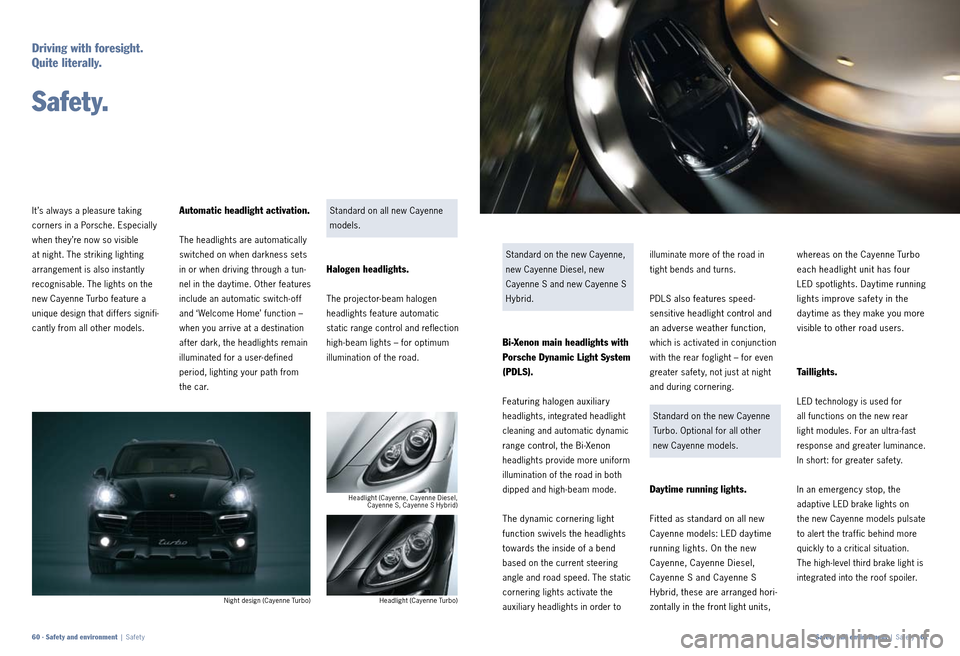
Standard on all new Cayenne
models.
Halogen headlights.
The projectorbeam halogen
headlights feature automatic
static range control and reflection
high beam lights – for optimum
illumination of the road.
Standard on the new Cayenne,
new Cayenne Diesel, new
Cayenne S and new Cayenne S
Hybrid.
Bi-Xenon main headlights with
Porsche Dynamic Light System
(PDLS).
Featuring halogen auxiliary
headlights, integrated headlight
cleaning and automatic dynamic
range control, the Bi Xenon
headlights provide more uniform
illumination of the road in both
dipped and high beam mode.
The dynamic cornering light
function swivels the headlights
towards the inside of a bend
based on the current steering
angle and road speed. The static
cornering lights activate the
auxiliary headlights in order to illuminate more of the road in
tight bends and turns.
PDLS also features speed
sensitive headlight control and
an adverse weather function,
which is activated in conjunction
with the rear foglight – for even
greater safet y, not just at night
and during cornering.
Standard on the new Cayenne
Turbo. Optional for all other
new Cayenne models.
Daytime running lights.
Fit ted as standard on all new
Cayenne models: LED day time
running lights. On the new
Cayenne, Cayenne Diesel,
Cayenne S and Cayenne S
Hybrid, these are arranged hori
zontally in the front light units, whereas on the Cayenne Turbo
each headlight unit has four
LED spotlights. Day time running
lights improve safet y in the
day time as they make you more
visible to other road users.
Taillights.
LED technology is used for
all functions on the new rear
light modules. For an ultra fast
response and greater luminance.
In short: for greater safet y.
In an emergency stop, the
adaptive LED brake lights on
the new Cayenne models pulsate
to alert the traf fic behind more
quickly to a critical situation.
The high level third brake light is
integrated into the roof spoiler.
Automatic headlight activation.
The headlights are automatically
switched on when darkness sets
in or when driving through a tun
nel in the day time. Other features
include an automatic switch of f
and ‘Welcome Home’ function –
when you arrive at a destination
after dark, the headlights remain
illuminated for a user defined
period, lighting your path from
the car.
It ’s always a pleasure taking
corners in a Porsche. Especially
when they’re now so visible
at night. The striking lighting
arrangement is also instantly
recog
nisable. The lights on the
new Cayenne Turbo feature a
unique design that differs signifi
cantly from all other models.
Driving with foresight.
Quite literally.
S a f e t y.
Night design (Cayenne Turbo) Headlight (Cayenne, Cayenne Diesel,
Cayenne S, Cayenne S Hybrid)
Headlight (Cayenne Turbo)
Safety and environment | Safet y · 61
60 · Safety and environment | Safet y
Page 30 of 68
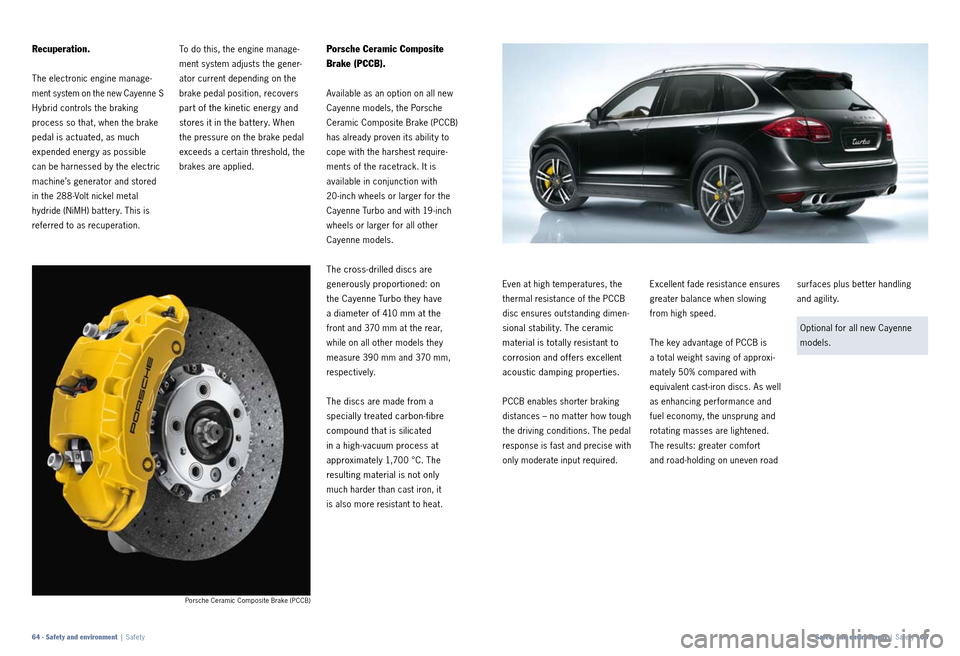
Porsche Ceramic Composite Brake (PCCB)
To do this, the engine manage
ment system adjusts the gener
ator current depending on the
brake pedal position, recovers
part of the kinetic energy and
stores it in the bat tery. When
the pressure on the brake pedal
exceeds a certain threshold, the
brakes are applied.
Porsche Ceramic Composite
Brake (PCCB).
Available as an option on all new
Cayenne models, the Porsche
Ceramic Composite Brake (PCCB)
has already proven its abilit y to
cope with the harshest require
ments of the racetrack. It is
available in conjunction with
20 inch wheels or larger for the
Cayenne Turbo and with 19 inch
wheels or larger for all other
Cayenne models.
The cross drilled discs are
generously proportioned: on
the Cayenne Turbo they have
a diameter of 410 mm at the
front and 370 mm at the rear,
while on all other models they
measure 390 mm and 370 mm,
respectively.
The discs are made from a
specially treated carbon fibre
compound that is silicated
in a high vacuum process at
approximately 1,700 °C. The
resulting material is not only
much harder than cast iron, it
is also more resistant to heat. Even at high temperatures, the
thermal resistance of the PCCB
disc ensures outstanding dimen
sional stabilit y. The ceramic
material is totally resistant to
corrosion and offers excellent
acoustic damping properties.
PCCB enables shorter braking
distances – no mat ter how tough
the driving conditions. The pedal
response is fast and precise with
only moderate input required. Excellent fade resistance ensures
greater balance when slowing
from high speed.
The key advantage of PCCB is
a total weight saving of approxi
mately 50% compared with
equivalent cast iron discs. As well
as enhancing performance and
fuel economy, the unsprung and
rotating masses are lightened.
The results: greater comfort
and road holding on uneven road surfaces plus bet ter handling
and agility.
Optional for all new Cayenne
models.
Recuperation.
The electronic engine manage
ment system on the new Cayenne S
Hybrid controls the braking
process so that, when the brake
pedal is actuated, as much
expended energy as possible
can be harnessed by the electric
machine’s generator and stored
in the 288 Volt nickel metal
hydride (NiMH) bat tery. This is
referred to as recuperation.
Safety and environment | Safet y · 65
64 · Safety and environment | Safet y
Page 31 of 68
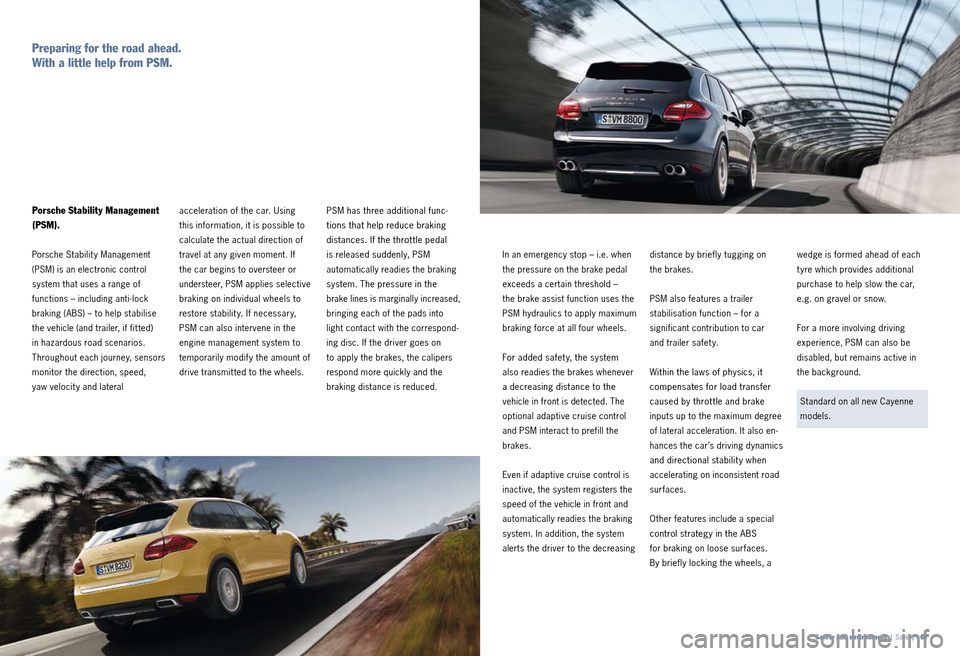
PSM has three additional func
tions that help reduce braking
distances. If the throt tle pedal
is released suddenly, PSM
automatically readies the braking
system. The pressure in the
brake lines is marginally increased,
bringing each of the pads into
light contact with the correspond
ing disc. If the driver goes on
to apply the brakes, the calipers
respond more quickly and the
braking distance is reduced. In an emergency stop – i.e. when
the pressure on the brake pedal
exceeds a certain threshold –
the brake assist function uses the
PSM hydraulics to apply maximum
braking force at all four wheels.
For added safet y, the system
also readies the brakes whenever
a decreasing distance to the
vehicle in front is detected. The
optional adaptive cruise control
and PSM interact to prefill the
brakes.
Even if adaptive cruise control is
inactive, the system registers the
speed of the vehicle in front and
automatically readies the braking
system. In addition, the system
alerts the driver to the decreasing distance by briefly tugging on
the brakes.
PSM also features a trailer
stabilisation function – for a
significant contribution to car
and trailer safet y.
Within the laws of physics, it
compensates for load transfer
caused by throt tle and brake
inputs up to the maximum degree
of lateral acceleration. It also en
hances the car’s driving dynamics
and directional stabilit y when
accelerating on inconsistent road
surfaces.
Other features include a special
control strategy in the ABS
for braking on loose surfaces.
By briefly locking the wheels, a wedge is formed ahead of each
t yre which provides additional
purchase to help slow the car,
e.g. on gravel or snow.
For a more involving driving
experience, PSM can also be
disabled, but remains active in
the background.
Standard on all new Cayenne
models.
accele
ration of the car. Using
this information, it is possible to
calculate the actual direction of
travel at any given moment. If
the car begins to oversteer or
understeer, PSM applies selective
braking on individual wheels to
restore stabilit y. If necessar y,
PSM can also intervene in the
engine management system to
temporarily modif y the amount of
drive transmit ted to the wheels.
Porsche Stability Management
(PSM).
Porsche Stabilit y Management
(PSM) is an electronic control
system that uses a range of
functions – including anti lock
braking (ABS) – to help stabilise
the vehicle (and trailer, if fit ted)
in hazardous road scenarios.
Throughout each journey, sensors
monitor the direction, speed,
yaw velocit y and lateral
Preparing for the road ahead.
With a little help from PSM.
Safety and environment | Safet y · 67
Page 32 of 68
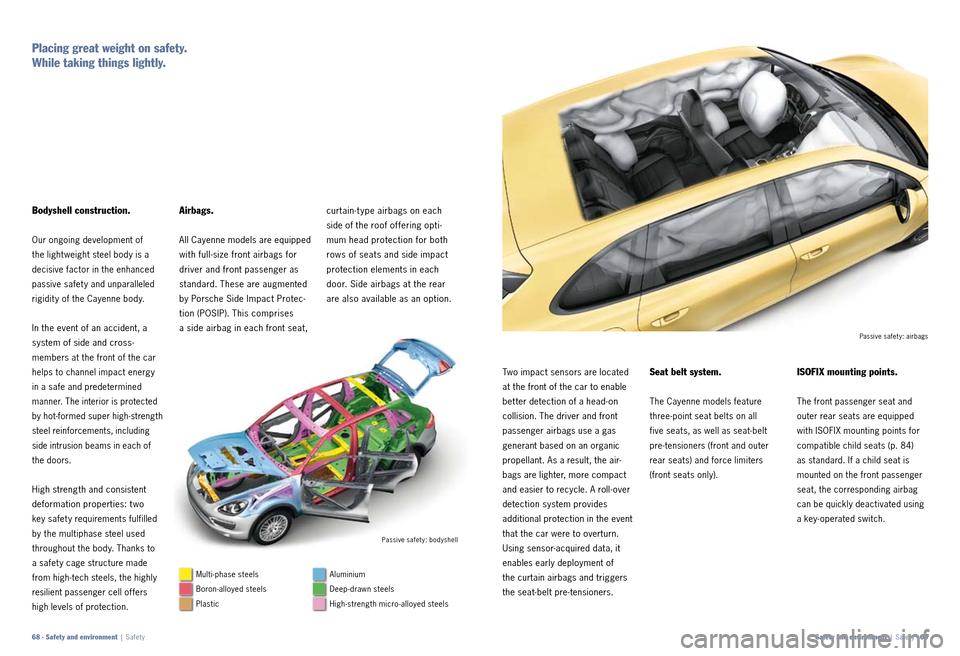
curtaint ype airbags on each
side of the roof offering opti
mum head protection for both
rows of seats and side impact
protection elements in each
door. Side airbags at the rear
are also available as an option.
Two impact sensors are located
at the front of the car to enable
bet ter detection of a headon
collision. The driver and front
passenger airbags use a gas
generant based on an organic
propellant. As a result, the air
bags are lighter, more compact
and easier to recycle. A roll over
detection system provides
additional protection in the event
that the car were to overturn.
Using sensor acquired data, it
enables early deployment of
the curtain airbags and triggers
the seat belt pre tensioners.
Seat belt system.
The Cayenne models feature
three point seat belts on all
five seats, as well as seat belt
pre tensioners (front and outer
rear seats) and force limiters
(front seats only).
ISOFIX mounting points.
The front passenger seat and
outer rear seats are equipped
with ISOFIX mounting points for
compatible child seats (p. 84)
as standard. If a child seat is
mounted on the front passenger
seat, the corresponding airbag
can be quickly deactivated using
a key operated switch.
Airbags.
All Cayenne models are equipped
with full size front airbags for
driver and front passenger as
standard. These are augmented
by Porsche Side Impact Protec
tion (POSIP). This comprises
a side airbag in each front seat,
Bodyshell construction.
Our ongoing development of
the light weight steel body is a
decisive factor in the enhanced
passive safet y and unparalleled
rigidit y of the Cayenne body.
In the event of an accident, a
system of side and cross
members at the front of the car
helps to channel impact energy
in a safe and predetermined
manner. The interior is protected
by hot formed super high strength
steel reinforcements, including
side intrusion beams in each of
the doors.
High strength and consistent
deformation properties: t wo
key safet y requirements fulfilled
by the multiphase steel used
throughout the body. Thanks to
a safet y cage structure made
from high tech steels, the highly
resilient passenger cell of fers
high levels of protection.
Placing great weight on safety.
While taking things lightly.
Passive safet y: airbags
Safety and environment | Safet y · 69
68 · Safety and environment | Safet y Passive safet y: bodyshell
Multi
phase steels
Boron alloyed steels
Plastic Aluminium
Deep
drawn steels
High strength micro alloyed steels